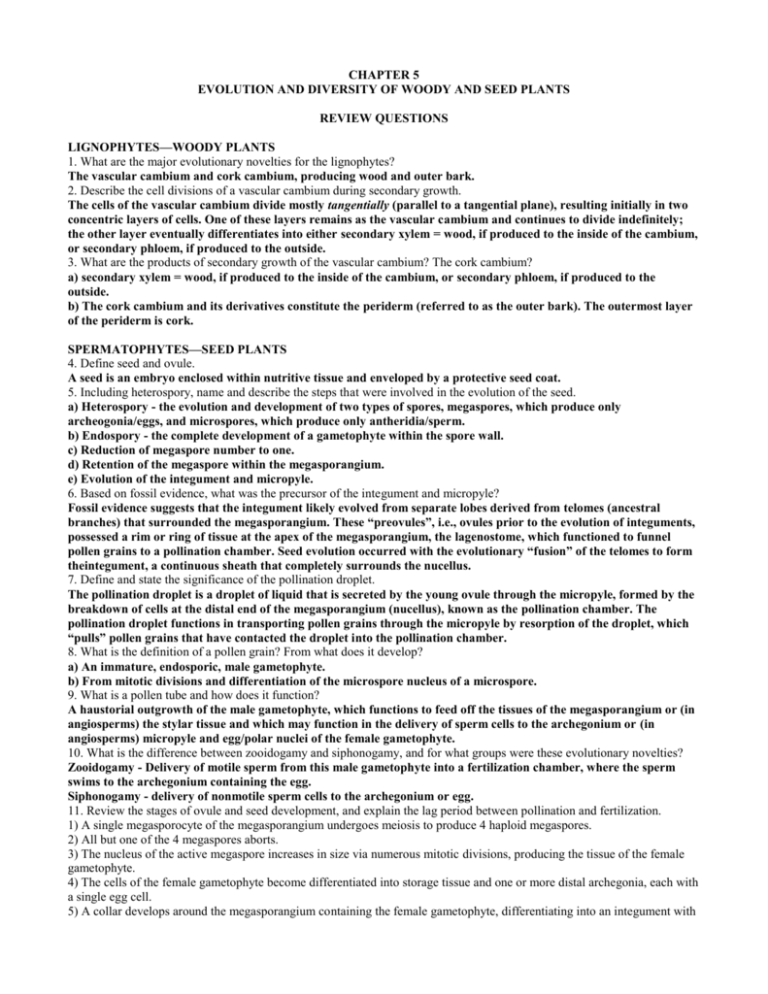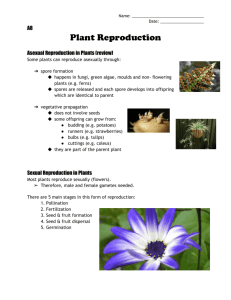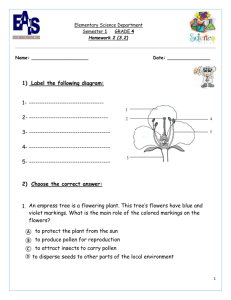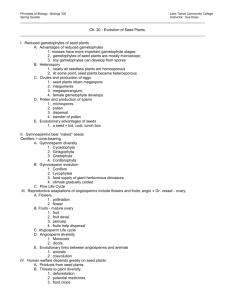CHAPTER 5 EVOLUTION AND DIVERSITY OF WOODY AND SEED
advertisement

CHAPTER 5 EVOLUTION AND DIVERSITY OF WOODY AND SEED PLANTS REVIEW QUESTIONS LIGNOPHYTES—WOODY PLANTS 1. What are the major evolutionary novelties for the lignophytes? The vascular cambium and cork cambium, producing wood and outer bark. 2. Describe the cell divisions of a vascular cambium during secondary growth. The cells of the vascular cambium divide mostly tangentially (parallel to a tangential plane), resulting initially in two concentric layers of cells. One of these layers remains as the vascular cambium and continues to divide indefinitely; the other layer eventually differentiates into either secondary xylem = wood, if produced to the inside of the cambium, or secondary phloem, if produced to the outside. 3. What are the products of secondary growth of the vascular cambium? The cork cambium? a) secondary xylem = wood, if produced to the inside of the cambium, or secondary phloem, if produced to the outside. b) The cork cambium and its derivatives constitute the periderm (referred to as the outer bark). The outermost layer of the periderm is cork. SPERMATOPHYTES—SEED PLANTS 4. Define seed and ovule. A seed is an embryo enclosed within nutritive tissue and enveloped by a protective seed coat. 5. Including heterospory, name and describe the steps that were involved in the evolution of the seed. a) Heterospory - the evolution and development of two types of spores, megaspores, which produce only archeogonia/eggs, and microspores, which produce only antheridia/sperm. b) Endospory - the complete development of a gametophyte within the spore wall. c) Reduction of megaspore number to one. d) Retention of the megaspore within the megasporangium. e) Evolution of the integument and micropyle. 6. Based on fossil evidence, what was the precursor of the integument and micropyle? Fossil evidence suggests that the integument likely evolved from separate lobes derived from telomes (ancestral branches) that surrounded the megasporangium. These “preovules”, i.e., ovules prior to the evolution of integuments, possessed a rim or ring of tissue at the apex of the megasporangium, the lagenostome, which functioned to funnel pollen grains to a pollination chamber. Seed evolution occurred with the evolutionary “fusion” of the telomes to form theintegument, a continuous sheath that completely surrounds the nucellus. 7. Define and state the significance of the pollination droplet. The pollination droplet is a droplet of liquid that is secreted by the young ovule through the micropyle, formed by the breakdown of cells at the distal end of the megasporangium (nucellus), known as the pollination chamber. The pollination droplet functions in transporting pollen grains through the micropyle by resorption of the droplet, which “pulls” pollen grains that have contacted the droplet into the pollination chamber. 8. What is the definition of a pollen grain? From what does it develop? a) An immature, endosporic, male gametophyte. b) From mitotic divisions and differentiation of the microspore nucleus of a microspore. 9. What is a pollen tube and how does it function? A haustorial outgrowth of the male gametophyte, which functions to feed off the tissues of the megasporangium or (in angiosperms) the stylar tissue and which may function in the delivery of sperm cells to the archegonium or (in angiosperms) micropyle and egg/polar nuclei of the female gametophyte. 10. What is the difference between zooidogamy and siphonogamy, and for what groups were these evolutionary novelties? Zooidogamy - Delivery of motile sperm from this male gametophyte into a fertilization chamber, where the sperm swims to the archegonium containing the egg. Siphonogamy - delivery of nonmotile sperm cells to the archegonium or egg. 11. Review the stages of ovule and seed development, and explain the lag period between pollination and fertilization. 1) A single megasporocyte of the megasporangium undergoes meiosis to produce 4 haploid megaspores. 2) All but one of the 4 megaspores aborts. 3) The nucleus of the active megaspore increases in size via numerous mitotic divisions, producing the tissue of the female gametophyte. 4) The cells of the female gametophyte become differentiated into storage tissue and one or more distal archegonia, each with a single egg cell. 5) A collar develops around the megasporangium containing the female gametophyte, differentiating into an integument with a micropyle, through which the pollen grain enters. 12. Name four ways that seeds are adaptive. First, seeds provide protection, mostly by means of the seed coat, from mechanical damage, desiccation, and often predation. Second, seeds function as the dispersal unit of sexual reproduction. Third, the seed coat may function in dormancy mechanisms that ensure germination of the seed only under ideal conditions of temperature, sunlight, or moisture. Fourth, upon germination, the nutritive tissue surrounding the embryo provides energy for the young seedling, aiding in successful establishment. 13. Name and describe the stem stelar type that is an apomorphy for all extant seed plants. Eustele - a primary stem vasculature that consists of a single ring of discrete vascular bundles. Each vascular bundle contains an internal strand of xylem and an external strand of phloem that are radially oriented, i.e., positioned along a radius. SEED PLANT DIVERSITY 14. What were the basic features of Archeopteris? Archeopteris was a large tree, with wood like a conifer but leaves like a fern. Sporangia, producing spores, were born on fertile branch systems. Some species of Archeopteris were heterosporous. 15. What is a “pteridosperm” (“seed fern”)? Name a genus of the “seed ferns.” The “pteridosperms,” or “seed ferns,” are almost certainly a paraphyletic group of fossil plants that had fernlike foliage, yet bore seeds. Medullosa, including the form genera Alethopteris, Neuropteris, Dolerotheca, and Pachytesta. 16. What is a gymnosperm, why are they called that, and what major groups are included within extant gymnosperms? Gymnosperms are one of two sister groups (clades) of extant seed plants. They are called that because the ovules are not enclosed by a surrounding carpel layer (thus, being “naked”) at the time of pollination. Major groups of gymnosperms are the Cycadophyta, Ginkgophyta, and Coniferae (Pinophyta). 17. What group of seed plants is characterized by generally short trunks, pinnate (rarely bipinnate), coriaceous leaves with circinate vernation, dioecy, and motile sperm? Cycadophyta - the cycads. 18. What is the definition of a cone (strobilus)? What are the parts of a seed cone? A pollen cone? A cone is an axis that bears sporophylls, each of which bear sporangia. A seed cone (if “simple”) consists of an axis bearing megasporophylls, each of which bears one or more ovules. A pollen cone consists of an axis bearing microsporophylls, each of which bears typically numerous microsporangia. 19. What are the diagnostic features of the Cycadaceae? Name an economically important member and its use. a) Generally short trunks, pinnate (rarely bipinnate), coriaceous leaves with circinate vernation, dioecy, and motile sperm. b) Cycas revoluta, sago-palm), food derived from the pith of the trunk (known as “sago,” made into a flour/bread. 20. How does the Zamiaceae differ with regard to reproductive morphology and genus diversity from the Cycadaceae? Zamiaceae has both seed and pollen cones, and contains 10 genera. The Cycadaceae has only pollen cones, the ovules born on megasporophylls not organized in a cone, and contains a single genus. 21. What group/species is a dioecious tree with short shoots, obtriangular leaves with dichotomous venation? Ginkgophyta - ginkgophytes, Ginkgo biloba. 22. What is the definition of a pine fascicle? A fascicle is a specialized short shoot consisting of stem tissue, one or more needle-shaped leaves, and persistent basal bud scales. 23. What is the morphology of some conifer pollen grains? What is the possible function of this morphology? The pollen grains of some (but not all) conifers are bisaccate, in which two bladder-like structures develop from the pollen grain wall. These saccate structures, like air bladders, may function to transport the pollen more efficiently by wind. They may also function as flotation devices, to aid in the capture and transport of pollen grains by a pollination droplet formed in the nonflowering seed plants. 24. What is the name of the structure in a female pine cone that directly bears the ovules/seeds? From what was it evolutionarily derived? What subtends this structure? a) Ovuliferous scale. b) A flattened branch system. c) A bract. 25. What are the diagnostic features of the Pinaceae? Name several genera (scientific and common names) in the family. The Pinaceae are distinctive in being trees [very rarely shrubs] with simple, linear to acicular, spiral leaves, relatively small pollen cones, with two abaxial microsporangia per microsporophyll, and seed cones with woody, ovuliferous scales, each usually bearing two adaxial, inverted ovules/seeds, the seeds usually winged, embryos with multiple cotyledons. Genera include Abies, firs, Cedrus, cedars, Picea, spruces, Pinus, pines, Pseudotsuga, Douglas-firs, and Tsuga, hemlocks. 26. How do the Araucariaceae and Cupressaceae vary with respect to leaf morphology, microsporangia number, and ovule number per scale? Name two important species of each family? Araucariaceae - Leaves spiral or opposite, and broad to acicular; microsporangia 5–20 per microsporophyll, pendant (inverted); ovules one per scale. Cupressaceae - Leaves spiral, opposite-decussate, or in whorls of 3–4, the shape linear, acicular, or deltoid-subulate; microsporangia 2-10 per microsporophyll; ovuliferous scales each with usually several (2–20) adaxial ovules. 27. What is distinctive about the Podocarpaceae with respect to seed cone structure? The seed cones with ovuliferous scales bearing one ovule, entire cone often reduced to one seed, sometimes borne on a fleshy receptacle, the seed often enveloped by a fleshy epimatium and carpidium. 28. What layer covers the seeds of the Taxaceae and what is its function? Seeds are covered by a fleshy, usually brightly colored aril, functioning in seed dispersal. 29. Name two apomorphies for the Gnetales. Striate pollen and vessels with porose (porelike) perforation plates. 30. Review the diagnostic features of the Ephedraceae. What is the family’s common name? Economic importance? The Ephedraceae are distinguished in being mostly dioecious shrubs, vines, or small trees with narrow, striate, photosynthetic aerial stems, the leaves scale-like, opposite or whorled, the pollen cones with decussate bracts subtending microsporangiophores, each bearing apical synangia and subtended by an outer bract and two, inner connate bracteoles, the seed cones bearing 1–3 ovules, each ovule subtended by a bract and enclosed by an outer layer (“envelope”) of connate bracteoles and an inner integument, the latter forming a protruding pollination tube, the seeds winged or fleshy. 31. Name the other two families and genera of the Gnetales. What do they look like and were do they occur? Gnetaceae - Gnetum - tropical vines (rarely trees or shrubs) with opposite (decussate), simple leaves. Welwitschiaceae - Welwitschia (W. mirabilis) native to deserts of Namibia in southwestern Africa; an underground caudex bears only two leaves, these becoming quite long and lacerated in old individuals.








